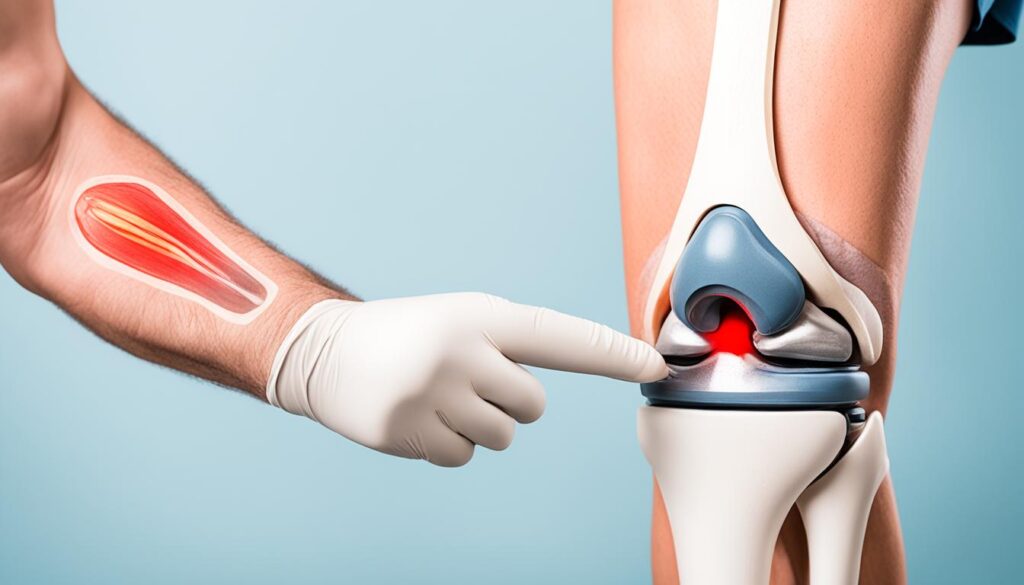Welcome to our comprehensive guide on knee osteoarthritis. In this article, we will delve into the key aspects of this degenerative joint condition, particularly focusing on who is most at risk and the associated factors. Knee osteoarthritis is a prevalent health concern, affecting millions of individuals worldwide. By understanding the risk factors and prevalence of knee osteoarthritis, we can better equip ourselves with knowledge for prevention and management.
Knee osteoarthritis is a condition that primarily affects the knees, but can also impact other joints such as hips, spine, and hands. While it is more commonly observed in individuals over the age of 55, it can affect people of all age groups. However, the prevalence is higher in older adults. About 73% of knee osteoarthritis cases occur in individuals over the age of 55, highlighting the significance of age as a risk factor. Moreover, women are more likely to develop knee osteoarthritis compared to men, making gender an important consideration.
Thank you for joining us on this journey to explore knee osteoarthritis. In the following sections, we will discuss the risk factors associated with knee osteoarthritis, the prevalence of the condition, common risk factors, and its impact on different demographics. Stay tuned for valuable insights and expert analysis.
Risk Factors for Knee Osteoarthritis
In order to understand the development of knee osteoarthritis, it is important to consider the various risk factors that play a role in its occurrence. These factors can include advanced age, gender, obesity, genetics, occupation, and previous knee injuries.
Age and Knee Osteoarthritis
One of the most significant risk factors for knee osteoarthritis is advanced age. Studies have shown that the majority of cases occur in individuals over the age of 55. As we age, the wear and tear on our joints increases, making them more susceptible to degeneration and the development of osteoarthritis.
Gender and Knee Osteoarthritis
Another important risk factor for knee osteoarthritis is gender. Women are more likely to develop knee osteoarthritis compared to men. This may be attributed to hormonal and anatomical differences, as well as the potential impact of pregnancy and childbirth on the joints.
Obesity and Knee Osteoarthritis
Obesity is a well-established risk factor for knee osteoarthritis. Excess weight puts added stress on the knee joints, increasing the likelihood of joint degeneration. Studies have shown that individuals who are overweight or obese are more likely to develop knee osteoarthritis compared to those who maintain a healthy weight.
Genetics and Knee Osteoarthritis
Genetics can also influence the likelihood of developing knee osteoarthritis. Certain genes have been associated with an increased risk of developing the condition. While genetics may play a role, it is important to note that other factors, such as lifestyle and environmental factors, also contribute to the development of knee osteoarthritis.
Occupation and Knee Osteoarthritis
Occupation can also contribute to the development of knee osteoarthritis. Jobs that involve prolonged standing or repetitive knee bending, such as construction work or healthcare professions, can increase the risk of joint degeneration. The repetitive stress placed on the knee joints throughout the workday may contribute to the development of knee osteoarthritis over time.
Knee Injuries and Knee Osteoarthritis
Previous knee injuries, such as ligament tears or fractures, can also increase the risk of developing knee osteoarthritis. These injuries can disrupt the normal structure and function of the knee joint, leading to accelerated joint degeneration and the onset of osteoarthritis.

Understanding the risk factors associated with knee osteoarthritis is essential for both prevention and management. By identifying individuals who are at higher risk, healthcare professionals can provide targeted interventions and advice to reduce modifiable risk factors, such as weight management or workplace modifications, and improve overall joint health.
| Risk Factors | Impact on Knee Osteoarthritis |
|---|---|
| Age | Elevated risk, majority of cases occur in individuals over 55 |
| Gender | Higher risk for women compared to men |
| Obesity | Increased stress on knee joints, higher risk |
| Genetics | Specific genes associated with increased risk |
| Occupation | Prolonged standing or repetitive knee bending increases risk |
| Knee Injuries | Ligament tears or fractures can lead to accelerated joint degeneration |
Prevalence of Knee Osteoarthritis
The prevalence of knee osteoarthritis can vary depending on the population studied and the diagnostic criteria used. However, it is estimated that the knee is the most frequently affected joint, with about 365 million people worldwide living with knee osteoarthritis. This accounts for a significant portion of the overall prevalence of osteoarthritis.
The prevalence of knee osteoarthritis is highest in older age groups, with the majority of cases occurring in individuals over the age of 55. As the population continues to age, these numbers may increase further in the future. Additionally, the rising rates of obesity and joint injuries contribute to the increasing prevalence of knee osteoarthritis.
To gain a better understanding of the prevalence of knee osteoarthritis, it is important to consider the impact it has on individuals and society as a whole. This condition can significantly affect a person’s quality of life and lead to disabilities that impact daily activities. By addressing the risk factors associated with knee osteoarthritis and implementing preventative measures, we can work towards reducing its prevalence and improving the overall well-being of individuals affected by this condition.
Common Risk Factors for Knee Osteoarthritis
Several common risk factors are associated with the development of knee osteoarthritis.
- Obesity: Excess weight puts added pressure on the knee joints and can contribute to joint degeneration. Obesity is a significant risk factor for knee osteoarthritis, and maintaining a healthy weight can help reduce the risk.
- Occupation: Certain occupations that involve repetitive knee movements or prolonged standing can increase the risk of developing knee osteoarthritis. Jobs in industries such as construction, manufacturing, and healthcare are particularly prone to this risk. It is crucial for individuals working in these fields to take necessary precautions and implement ergonomic practices to minimize knee strain.
- Knee Injuries: Previous knee injuries, such as ligament tears or fractures, can increase the likelihood of developing knee osteoarthritis later in life. Once an injury has occurred, it is important to seek appropriate medical treatment and engage in rehabilitation exercises to promote knee joint health and reduce the risk of further complications.
Understanding and addressing these risk factors are key steps in preventing the development and progression of knee osteoarthritis. By maintaining a healthy weight, using proper body mechanics at work, and taking proactive measures to prevent knee injuries, individuals can significantly reduce their risk of developing this debilitating condition.

Prevalence of Knee Osteoarthritis Among Different Demographics
The prevalence of knee osteoarthritis can vary among different demographics. It is influenced by factors such as age and gender, among others. Understanding the distribution of knee osteoarthritis across various populations is crucial in developing effective prevention and management strategies.
Age and Knee Osteoarthritis
Age is a significant risk factor for knee osteoarthritis. The majority of cases occur in individuals over the age of 55. As people age, the wear and tear on their joints can lead to the development of osteoarthritis. The knee joint, in particular, is highly susceptible to degeneration with advancing age.
Gender and Knee Osteoarthritis
Women are more likely to develop knee osteoarthritis compared to men. This gender disparity in prevalence suggests that hormonal, anatomical, and biomechanical differences may contribute to the increased susceptibility of women to knee osteoarthritis. Hormonal changes during menopause, for example, can play a role in the development and progression of the condition.
Impact on Different Age Groups and Genders
While knee osteoarthritis is more common in older individuals and females, it can affect people of all ages and genders. It is essential to recognize that knee osteoarthritis is not exclusively an age-related condition. Younger individuals, particularly those with genetic predispositions or previous knee injuries, can also develop knee osteoarthritis.
By assessing the prevalence of knee osteoarthritis among different demographics, we can gain valuable insights into the unique factors influencing its development in specific populations. These insights can inform targeted interventions and improve outcomes for individuals with knee osteoarthritis.
Conclusion
Knee osteoarthritis is a prevalent condition that affects a significant number of people worldwide. The risk factors for knee osteoarthritis include advancing age, female gender, obesity, genetics, occupation, and previous knee injuries. It is estimated that the knee joint is the most commonly affected joint, with a high prevalence among individuals over the age of 55.
Understanding the risk factors and prevalence of knee osteoarthritis is crucial for developing strategies aimed at prevention, early detection, and effective management of this condition. By promoting awareness and implementing interventions targeted at reducing modifiable risk factors, we can help mitigate the impact of knee osteoarthritis on individuals and improve their overall quality of life.
As healthcare professionals, it is our responsibility to educate and empower individuals to make informed decisions about their health. By adopting a proactive approach and addressing the risk factors associated with knee osteoarthritis, we can contribute to reducing the prevalence and burden of this condition. Together, let us work towards a future where knee osteoarthritis is better understood, prevented, and managed, leading to healthier and happier lives for all.
FAQ
Who is at risk of developing knee osteoarthritis?
The risk of developing knee osteoarthritis increases with advanced age, particularly in individuals over the age of 55. Women are also more likely to develop knee osteoarthritis compared to men. Other risk factors include obesity, genetics, certain occupations, and previous knee injuries.
What are the risk factors for knee osteoarthritis?
The risk factors for knee osteoarthritis include age, gender, obesity, genetics, occupation, and previous knee injuries. Advanced age and being female are significant risk factors. Obesity can put added stress on the knee joints, increasing the likelihood of osteoarthritis. Certain occupations that involve repetitive knee movements or prolonged standing can also contribute to the development of knee osteoarthritis. Additionally, previous knee injuries, such as ligament tears or fractures, can increase the risk.
What is the prevalence of knee osteoarthritis?
Knee osteoarthritis is a prevalent condition, with the knee joint being the most commonly affected. It is estimated that about 365 million people worldwide are living with knee osteoarthritis. However, the prevalence can vary depending on the population studied and the diagnostic criteria used.
What are the common risk factors for knee osteoarthritis?
Common risk factors for knee osteoarthritis include obesity, certain occupations, and previous knee injuries. Excess weight puts added pressure on the knee joints, increasing the risk of osteoarthritis. Jobs that involve repetitive knee movements or prolonged standing, such as those in construction or healthcare, can also contribute to the development of knee osteoarthritis. Additionally, previous knee injuries, such as ligament tears or fractures, can raise the likelihood of developing osteoarthritis in the knee later in life.
How does the prevalence of knee osteoarthritis vary among different demographics?
The prevalence of knee osteoarthritis is highest in older age groups, with the majority of cases occurring in individuals over the age of 55. Women are also more likely to develop knee osteoarthritis compared to men. However, it is important to note that knee osteoarthritis can affect individuals of all ages and genders. The prevalence may also vary across different populations and geographic regions.

Leave a Reply